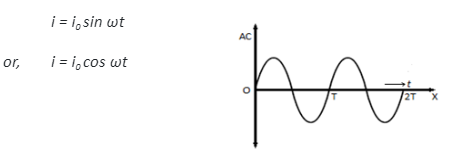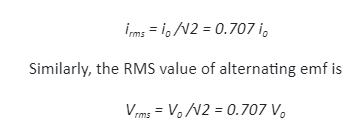Introduction
Alternating current (AC) is the flow of electric charge whose magnitude changes continuously with time and its direction reverses periodically. Most of the electric power generated and used worldwide is in the form of alternating current.
In most electric circuits, the waveform of AC is a sine wave, whose positive half corresponds with the positive direction and the negative half corresponds to the negative direction of the current. It is represented as –

Where i is the magnitude of current at any instant of time t, i0 is the maximum value of AC (amplitude) and ω is the angular frequency of AC.
History
French instrument maker Hippolyte Pixii constructed the first electrical generator in 1832 to produce alternating current, a dynamo-electric generator based on Faraday’s principles. The first application of AC was in electrotherapy by its inventor Guillaume Duchenne. After that, the AC was developed by the Hungarian Ganz Works Company (the 1870s) and many more developments took place to form the present-day AC equipment for our use.
Alternator
AC alternators generate electrical energy in the form of alternating current at a specific voltage and frequency from mechanical energy coming from a rotor. The direct field current energises the magnetic pole of the rotor. Magnetic flux from the rotor cuts the stator conductor, thus inducing EMF. An electric current flows as the magnetic poles alternate, rotating clockwise and then anti-clockwise. This induces an EMF and a current flowing through the armature, which first rotates in a clockwise direction and then in an anti-clockwise direction. Thus, an alternating current is produced.
Properties of AC
- An alternating current is an electric current that changes its direction in specific time intervals.
- Alternating current and voltage can be increased or decreased with the help of a transformer, and hence it is used on a large scale.
- The waveform of the AC cycle is similar to that of a sine curve.
- This is the main type of current used in businesses and residences.
- AC is more dangerous than DC as AC with less frequency is more dangerous than DC having the same voltage level.
- AC at high frequency is dangerous as the current flows on the surface of the wire.
Average value or mean value of AC
When the steady current passes through a circuit for half the time period of alternating current, it sends the same amount of charge as done by the alternating current at the same time through the same circuit, which is called the mean or average value of alternating current. It is denoted as iav.
Therefore, the mean value of AC during the half-cycle is 0.636 times or 63.6% of its peak value (i0).
Similarly, the mean or average value of alternating emf is
RMS value
The steady current and the alternating current when passed through the same resistance and at the same time will produce the same amount of heat. This is the RMS (Root Mean Square) value of the Alternating Current. It is denoted by

A resistor in an AC Circuit
If an AC circuit is fed by an alternating emf V = V0 sin ωt and contains a pure resistance R, the current is
Therefore, in a purely resistive AC circuit, the voltage and current are in the same phase.
A Capacitor in an AC Circuit
If an AC circuit is fed by an alternating emf V = V0 sin ωt and contains a pure capacitance C, the current is
i = i0 sin (ωt + π/2)
Therefore, in a purely capacitive AC circuit, the voltage phasor lags the current phasor by 90˚ or /2.
An Inductor in an AC Circuit
If an AC circuit is fed by an alternating emf V = V0 sin ωt and contains a pure inductance L, the current is
i = i0 sin (ωt – π /2)
Therefore, in a purely capacitive AC circuit, the voltage phasor leads the current phasor by 90˚ or /2.
The fundamentals of AC power
The AC power is defined as the rate at which work is being done in the AC circuit. The emf and the current in the AC circuit are represented as –

Where cos θ = (Resistance/ Impedance) is called the Power factor of the AC circuit.
Characteristics of AC power
The five characteristics of AC power are –
- Amplitude
- Cycles
- Frequency
- Peak to Peak
- RMS.
Applications
In most appliances, AC power is used. For example, audio signals and radio signals are examples of alternating currents. A large advantage of alternating current over direct current is that it can transmit power over long distances without consuming a lot of energy.
The main reason AC is mostly used in homes and offices is that it is easier to generate and transport AC over long distances. Transformers are capable of converting low AC at high voltage to high AC at low voltage and vice-versa with ease. Electric motors can also be powered by AC, converting electrical energy into mechanical energy. Therefore, AC is also found in various large appliances such as refrigerators, dishwashers, and many more.
Conclusion
The direction and magnitude of an alternating current change periodically; the same concept also applies to alternating voltage. Alternating current is also governed by electrical principles, but it has certain attributes that need to be taken into account. In terms of the different types of alternating current, the sinusoidal wave is the most important.
 Profile
Profile Settings
Settings Refer your friends
Refer your friends Sign out
Sign out






